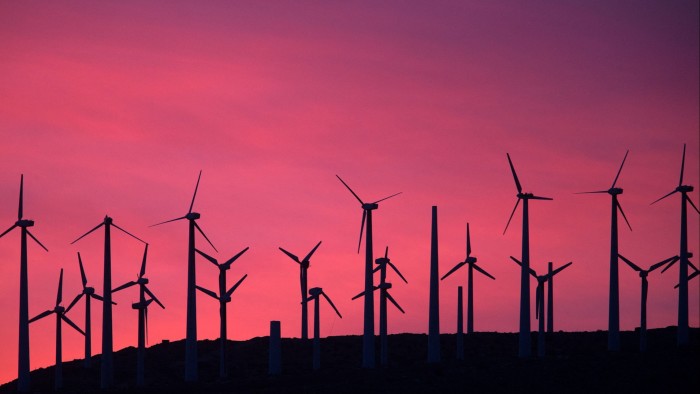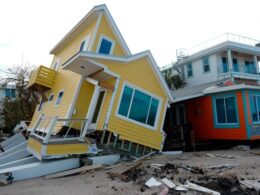Donald Trump’s restrictions on renewable energy risk sparking an electricity crisis in the US, driving up costs for consumers and handing China an edge in the global artificial intelligence race, industry executives have warned.
In his first week in office, the US president ordered a moratorium on offshore wind approvals and reviews of existing wind leases and paused hundreds of billions of dollars of incentives for green energy.
The actions have sent shockwaves across an industry that is the cheapest and fastest-growing source of new capacity on the US grid at a time of rising power demand.
By 2028, utilities will need to boost annual generation by as much as 26 per cent from 2023 levels to meet demand, far higher than any supply growth the US has achieved in the past two decades, according to consultancy Bain. Nearly 45 per cent of this demand growth is being driven by the construction of power-hungry data centres required to support the rollout of AI technologies.
“We’re going to need more juice and a lot of it . . . I’m not sure I see the wisdom in slowing down the development of any resource right now,” said Jim Robb, chief executive of the North American Electric Reliability Corporation, a regulatory body.
“I don’t think we want the AI infrastructure of the country to be dependent on the Middle East or China or India or any place else that has the power so that they can develop very quickly.”
The US race to lead in AI has driven a historic surge in US electricity consumption, prompting a rush among developers for electrons. Trump’s new “energy tsar” Doug Burgum has warned the US will lose the “AI arms race” to China unless it boosts generation from fossil fuels.
A White House spokesman said Trump’s economic policies — tariffs, tax cuts and deregulation — in his first term led to strong job growth, low unemployment and energy independence. These successes would define his second term, he added.
Competition with Beijing intensified last week when Hangzhou-based start-up DeepSeek launched a low-cost, more energy-efficient AI assistant, upending forecasts for power demand and expectations for an AI-driven boon for energy companies.
Many energy executives say renewables combined with battery storage are best positioned to meet any quick increase in power demand. Gas plants face longer timelines, supply constraints and higher costs, they say.
“It is not in anyone’s interest to drive up energy costs by driving procurement of thermal resources across the grid,” said David Mindham, director of regulatory and market affairs at EDP Renewables North America, a large renewables developer.
The levelised cost of electricity for solar and onshore wind, a widely used metric to compare the cost of different generation sources, is cheaper than any other source, even gas, because of years of falling prices for components and the support of federal tax credits, according to Lazard, an investment bank.
Trump has promised to slash energy bills in half within a year of taking office and boost oil and gas production, which sits at record levels, to tackle inflation.
In his first orders, Trump paused permits for renewable projects and withdrew the coastline for offshore wind leasing, a crucial electricity source for the north-east, which has fewer land resources and receives less sunlight.
The move has paralysed new investment in the renewables sector, which is bracing for further action by Trump and a Republican-controlled Congress, such as changes to tax credits in the Inflation Reduction Act that accelerated clean energy deployment. “There’s no doubt that the uncertainty that’s happening with these executive orders will likely impact build,” said Helen Kou, a power analyst at BloombergNEF.
Ninety per cent of the 100 gigawatts of new capacity expected to come online over the next couple of years, about the size of Mexico’s electricity system, is forecast to come from renewable sources and batteries, according to BloombergNEF.
Mark Brownstein, senior vice-president of energy transition at the Environmental Defense Fund, said Trump’s orders “flew in the face of good economics” and dented US competitiveness.
“This doesn’t make sense. If you believe that there is a national energy emergency and we need lots of new power — why would you arbitrarily take some of the cheapest options off the table?”
Executives also warned that a slowdown in renewable project construction would put the grid at a greater risk of outages. Several large developers have slowed down or pulled out of projects since the November election, including oil majors Shell and TotalEnergies.
“There will be more blackouts,” said Claire Broido Johnson, co-founder of Sunrock Distributed Generation, a solar developer. “He is hoping oil and gas will solve all of his problems . . . It just can’t.”
The California Independent System Operator, which oversees the state’s grid, said its 25GW of clean electricity capacity growth over the past five years had been “instrumental” in maintaining reliability. Southwest Power Pool, another regional operator, said its wind resources had provided support during times of unexpected demand.
ISO New England, the North-east operator, said it did not yet foresee reliability challenges from Trump’s orders, but added that wind was “the most energy-dense thing that we have for an option” to meet demand growth.
“There is no question that if you see demand increasing and supply doesn’t keep up, you see increased chances of blackouts and brownouts,” said Kevin Smith, chief executive at Arevon Energy, a large solar and storage project developer.
Source link










